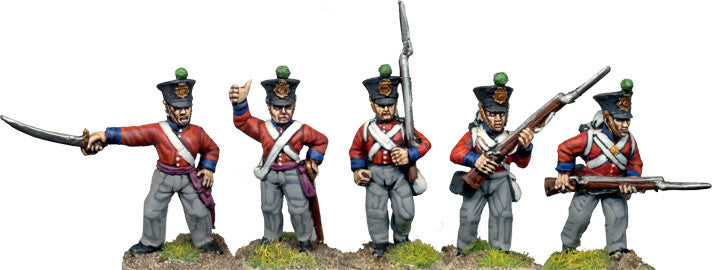BRITISH UNIFORMS OF THE 1ST AFGHAN WAR 1838-42
by John French
BRITISH INFANTRY

HEADGEAR: Bell-topped shakos with brass plates were used. They were often covered in black oilskins or white covers (for hot weather). If uncovered, ball tufts were used, green for light companies, white for remainder. Kilmarnock forage caps were also worn. These were black except for light infantry units such as 13th (Somersets), which had green. There was also a band around the bottom of the regiment’s facing colour. On top was a “tourie” (pom-pom). Again green for light companies and white for rest. Officers’ caps usually had peaks.

TUNICS: Home service dress red coatees with white lace. Facing colours of the British Regiments involved were blue, buff, white and yellow.. Battalion or centre companies had a red crescent on the shoulder. Flank companies (light and grenadier companies) had red, laced wings ending in white worsted tufts. Straps attaching these to the shoulder were in facing colour outlined in white. Officers had gold epaulettes and straps for battalion companies and gold wings for flank companies.
If the undress shell jacket was used this was red with gilt or pewter buttons. Collar, cuffs and shoulder straps were in the facing colours. Flank companies with plain shoulder wings. Officers/N.C.O. had waist sashes in crimson, tied on left for grenadier and battalion companies, and at the rear for light companies.


TROUSERS: Oxford mixture of a blue-black shade, with red stripe, or blue dungaree (various shades according to wear), was worn in cold weather with white trousers for hot weather wear.
EQUIPMENT: Cross-belts white, cartridge boxes, bayonet scabbards black, haversacks unbleached linen. Blankets buff with dark red stripe. Greatcoats if used were grey. Afghan coats (poshteens) were often worn by officers in cold weather along with locally made boots.

STANDARDS: At this time they were usually six foot on the pike and six foot six inches wide. Regiments carried a “Royal Colour”, or First Colour, this was a Union Flag (Jack) with the appropriate regimental numbering in the centre. A “Regimental Colour” or Second Colour, was also carried, usually a field of the uniform facing colour with a Union flag in upper canton near hoist. In the centre was a wreath surrounding the regimental number and battle honours displayed on scrolls where appropriate. Not all battle honours were awarded soon after the campaigns. In some cases there could be fifty years before an award was granted. Up until 1844 battle honours were placed on both colours.

16th Lancers: The uniform worn was the same as for “Home Service”. The only concession to the heat was the white lance-cap covers. The red jacket had a dark blue collar and gold lace. A gold waist sash had two red stripes running through it. Trousers or overalls were blue with two red stripes, and leather equipment was white. Horse tack was light brown.

4th Light Dragoons: Scarlet jackets, faced light green were worn from 1836-42. From 1842 onwards this was changed to blue jackets faced scarlet.

BENGAL HORSE ARTILLERY: Uniforms similar to Bombay H.A. except plumes were red. Overalls had double gold stripes. Shabraques and sabretaches were blue with gold embroidery. European other ranks similar except yellow lace replaced gold and white breeches were worn up until 1847. Unlike the Royal Horse Artillery (R.H.A.), the Bengal H.A. crews tended to ride the horse teams rather than their own horses. There could therefore be six riders on the gun team plus crew on the limber. R.H.A. usually had drivers only mounted on the gun teams, that is three men. In India at this time however, the artillery was supplied by the East India Company divisions.

BOMBAY HORSE ARTILLERY & FIELD ARTILLERY: Headgear - Helmet, black with cheetah skin turban/ pagri. Fittings were gilt, and the mane black. The brass plate on the front was similar to the Bengal Horse Artillery except for the wording. Jacket - dark blue, red facings, gold lace. Overalls - dark blue with gold stripe. Barrel sash crimson and gold. Equipment - pouch belt gold lace with red lines on edges and in centre. Pouch at this time also gilt. Sword belt and slings also with gold lace. Field and horse artillery were only really distinguished by the helmet plate with the appropriate wording.

BENGAL LIGHT CAVALRY: Undress jackets at this time were dark blue with silver lace, facings orange except 5th Regt. which was black. The more familiar French Grey was adopted in 1847. Barrel sashes were red and gold. Overalls were also dark blue with double silver stripes and sabretaches and shabraques dark blue with silver embroidery. The uniform of the native ranks followed a similar style. The shako was peakless and often worn with a white cover.

BENGAL NATIVE INFANTRY REGIMENTS: Facing colours of the regiments involved included yellow, white, green, buff and black. All lace was gold.
BOMBAY NATIVE INFANTRY REGIMENTS: Only a few regiments were involved. Facing colours were yellow or black. All lace was gold.

Click here for our article on the 1st Afghan War and the siege of Jellalabad by John French
